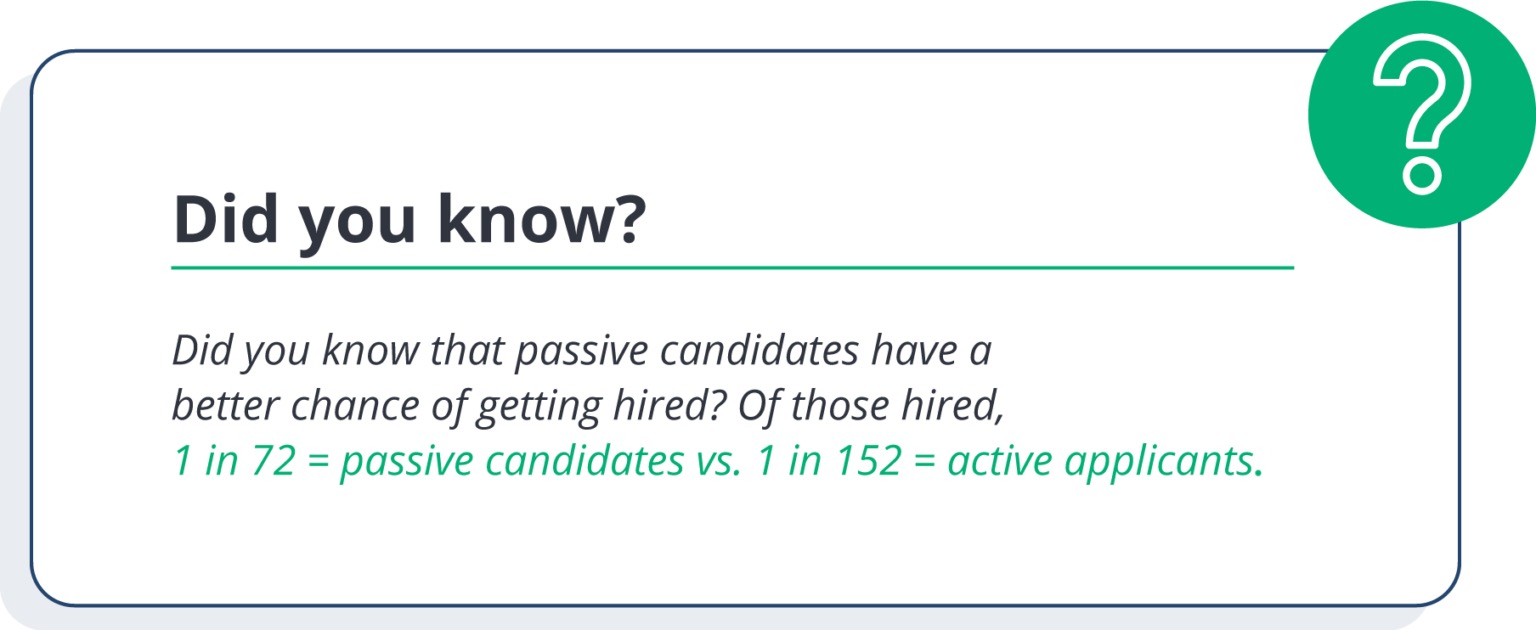LinkedIn estimates that nearly 70% of candidates consider themselves passive job seekers. So, if your organization is only looking for active candidates (those actively searching for new jobs), you’re only tapping into 30% of all available talent.
Amid such a tight labor market, recruiters must rethink strategies for finding and engaging top talent to ensure they’re looking at the entire talent pool, not just one corner. Below, we explain how you can tweak your strategy to appeal to both active and passive candidates.
Use the links below to jump ahead on the page.
- The Difference Between Active vs. Passive Search Strategies
- Active vs. Passive Candidates: Mindset
- How To Stand Out With Active Candidates
- Advantages of Recruiting Passive Candidates
- How To Attract Passive Candidates
The Difference: Active vs. Passive Search Strategies
In a competitive job market, it’s more important than ever to think creatively about recruiting. That’s why firms should make sure they’re using recruiting strategies for both passive and active candidates when seeking top talent for their organizations.
For both talent sources, you can sharpen the focus of your recruiting efforts by using specific keywords in online searches, reaching out to those who have recently changed jobs or positions, monitoring industry trends, and leveraging employee referrals.
Improving recruiter engagement for specific types of candidates starts with a better understanding of the motivations for each source.

Active vs. Passive Candidates: Candidate Mindset
Understanding what motivates each of these talent sources is crucial for successful recruiting in today’s ever-changing workforce.
Recruiters view active candidates as job seekers who are interested in being recruited. Because they are actively searching for jobs, candidates tend to be receptive to recruitment efforts — but that doesn’t mean they’re easy to find or recruit!
A candidate’s mindset can help shape your recruiting strategy by keeping context in mind: a variety of personal and professional reasons often prompt someone’s job hunt.
Active candidates may be finishing a gig, contract, or program of study. Some seek more challenging positions or opportunities to advance and may want to develop new skills. Other candidates seek relocation as they pursue a change in roles – or entire fields. Many more are simply unhappy in their current roles.
Passive candidates are a bit different. While both are recruitable, it can be tougher to get the ball rolling with candidates who are already comfortable in their current positions.
A passive candidate is usually more selective in their responses and will likely require more front-loaded info on a new opportunity to pique their interest. The benefits, though, may outweigh the higher up-front labor costs.
| Active Candidates | Passive Candidates |
|---|---|
| ✔ Ready to work
✔ Open to negotiation ✔ Faster replies to communication ✘ Harder to control for qualifications ✘ May be hired quickly by competing firms |
✔ Larger candidate pool
✔ Generally more qualified ✔ Easily targeted by specific qualifications ✘ More resistant to recruiting efforts ✘ Less likely to reply to comms |
How To Stand Out With Active Candidates
1. Use specific keywords when searching for candidates online. This will help you narrow your results to focus on those actively searching for new opportunities.
2. Reach out to individuals who have recently changed jobs or positions. These people are likely open to exploring new opportunities, thus more likely to be receptive to recruitment efforts.
3. Use social media to your advantage. Social media allows recruiters to reach out to potential candidates and gauge their interest in new opportunities.
You can also use social media to get a better understanding of their work experience and skill set.
4. Keep an eye on industry trends. Monitoring industry trends will help you identify when certain employees may be considering a change so you can reach out before they become active candidates.
For example, if you see a trend of employees leaving one company for another, you may want to reach out to them to see if they’re interested in hearing about other opportunities.
5. Use employee referrals. Employee referrals are one of the most effective ways to find quality candidates because you get recommendations from people who already know and trust your company.
Ask your employees if they know anyone who might be interested in open positions and reach out accordingly.
Advantages of Recruiting Passive Candidates
While many employers focus on recruiting candidates who are actively seeking new opportunities, there are many benefits to recruiting passive candidates, as well.
 Passive candidates are not actively seeking new employment but could be persuaded to leave their current positions for the right opportunity.
Passive candidates are not actively seeking new employment but could be persuaded to leave their current positions for the right opportunity.
These candidates are usually gainfully employed and aren’t searching job boards or attending career fairs. Because they aren’t actively looking for a new position, they can be a bit harder to find.
Target specific skills and experience
When you’re recruiting passive candidates, you can include more specific requirements than you might with active job seekers. You can target people who have the skills and experience that you need to fill a particular role.
This allows you to be much more selective in your hiring process, saving time and money in the long run.
They tend to be more qualified
Passive candidates are usually content in their current roles. This means they less likely to to jump ship at the first opportunity.
Passive candidates tend to be viewed as more qualified and have more experience than active candidates.
The way you approach recruiting #Active candidates differs from #Passive candidates. Brush up on the latest strategies and tips in @Visage_Jobs latest article:
Larger candidate pool
When you recruit passively, you open up your pool of potential candidates to include those who aren’t active job-seekers. With a much larger pipeline of talented individuals to choose from, your chances of finding the perfect fit for your organization also expand.
Avoid bidding wars
In a tight job market, it’s common for employers to find themselves in bidding wars for top talent. This can drive up salaries and cause tension among employees.
Recruiting passive candidates can prevent these situations because the strategy avoids such visible competition. Your offer could drive up a compensation package for a candidate who’s happy in their current role.
In the long run, however, bypassing a public bidding war can save you money and keep morale high among existing employees.
How To Attract Passive Candidates
Use social media platforms to your advantage
Social media platforms can be instrumental in finding top performers. Many social networks allow you to search for potential candidates based on specific criteria like job title, company size, or location.
Other platforms allow you to view a candidate’s portfolio or body of work.
Still others feature candidates interested in specific work-related topics, allowing recruiters and sourcers to weigh in on conversations and build relationships.
78% of recruiters expect the use of social media for finding candidates will increase, so failing to take advantage of a social media presence could harm your ability to attract passive candidates.
Leverage employee referral programs
Employee referral programs are another great way to find top performers. These forums allow your existing employees to refer candidates they think would be a good fit for open positions.
Employee referral programs often result in higher applicant quality because your employees are more likely to refer people they know are qualified and would be a good fit for the company culture.
From 5 Sure-Fire Strategies for Sourcing Passive Candidates
As you build out your employee referral program, keep the following in mind:
Make your employees feel appreciated for their referrals — employees like being appreciated, and when it comes to referrals, you should celebrate them when they’re given. It doesn’t have to be much. Show your team that you’re thankful for their help finding a quality candidate.
Keep the candidate and employee updated on the referral process — transparency in the hiring process is critical for a positive experience. Let your employee who made the referral know how the process is going, and keep your referral in the loop!
Be sure to reward engagement, not results — rewarding employees for referrals should occur immediately, even if the reward is small. The best referral programs are built around rewarding and encouraging referrals rather than rewarding a successful hire. Frequent rewards and recognition go a long way in keeping your team engaged with the process.
Get creative with sourcing strategies
There are many creative sourcing strategies you can use to find top performers. For example, you can host meetups or events to attract potential candidates.
You can also try contacting passive candidates through cold emailing or LinkedIn InMails. Another option is to work with a recruiting agency that specializes in finding top talent.
The best superpower recruiters have is making that candidate feel wanted. But that can’t happen until we have the opportunity to build relationships and the time to engage in meaningful conversations with those talented people who are not yet interested in us.
-Tim Sackett, TA & HR Expert
Highlight Internal Mobility and Development Opportunities
Passive candidates often crave professional development and growth.
Make sure you have growth and development plans in place, not only to attract passive candidates but for your current employees as well. Employees that undergo professional development are:
- 15% more engaged
- 34% more likely to stay within their role
Two factors that today’s candidates find extremely important are
a.) a healthy, strong workplace culture and
b.) bountiful growth opportunities.
Read More.
Create a Stellar Candidate Experience
Regardless of whether you’re recruiting passive or active candidates, putting the candidate’s experience first is essential to success.
A subpar experience means you’ll miss out on top talent, with a high chance of a negative impact on your employer brand.
When 72% of candidates report sharing their bad experiences online, putting the candidate first is crucial. Some ways to ensure a positive candidate experience include:
- Taking steps to eliminate unnecessary application steps or repetitive form fields.
- Optimizing mobile application capabilities to enable candidates to apply on the go.
- Staying on top of communication to ensure transparency at every stage of the process.
- Ensuring a seamless and simple onboarding process once an offer is accepted.
The key to a strong recruiting strategy is to create custom approaches for recruiting both passive and active candidates. With a lack of available talent on the market, organizations simply can’t afford to overlook an entire pool of candidates.
Learn More About Active vs Passive Candidates with Visage
Recruiting is a science, and companies that are focused on their industry may not have the in-house expertise needed to master the concept of active vs passive candidates for their use case– that’s where Visage comes in. For more advice on how to tweak your recruitment strategies, reach out to our team today.

Kevin is a seasoned Customer Success Manager, specializing in optimizing hiring processes and driving talent acquisition success for clients. He hails from Ireland, has lived in Portugal, and backpacked through the US, Central America, and South America. Besides his love of traveling, he adores all things sports, movies, and stand-up comedy.

